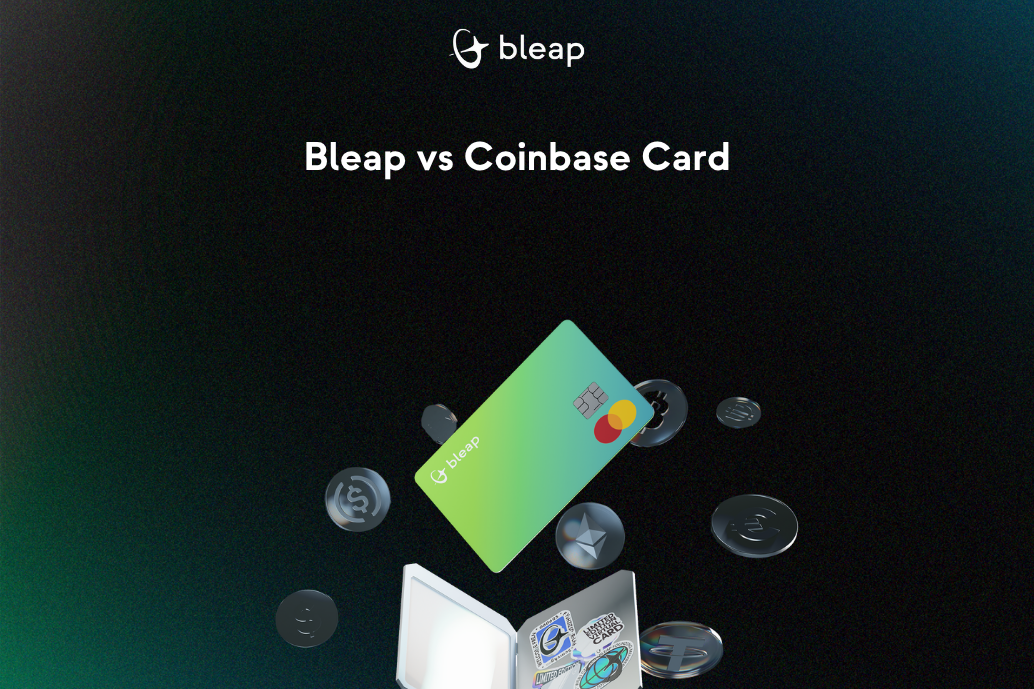
This content is for educational purposes only and should not be considered financial advice. Crypto investments carry risks, including loss of capital. Always do your own research or consult a licensed advisor before investing.
Bleap offers 2% cashback with no fees, while Coinbase Card applies a conversion charge on every purchase. This conversion acts as the main Coinbase credit card fee and reduces the real reward you earn. Bleap is non-custodial and fee-free, making it a more predictable financial choice for most users.
Users search “Bleap vs Coinbase Card” because they want clarity on fees and long-term cost. Coinbase has a complex multi-layer fee structure across trading, processing, conversions, and withdrawals. Bleap avoids this structure by offering a non-custodial wallet and zero spending fees.
This article explains each fee clearly and shows how they impact real cashback.
Coinbase fees apply across several layers of the platform. These costs influence the real value of using the Coinbase Card because every card purchase requires a crypto conversion.
Below is a clear breakdown of all Coinbase fees:
Coinbase does not charge a fee to store crypto or cash in your primary balance. Moving crypto between Coinbase users is free.
Sending crypto off Coinbase triggers network fees.
These vary based on blockchain congestion. Coinbase discloses the estimated fee during the transaction.
If Coinbase batches transactions, it may pay lower fees than the total collected.
Fees may apply when adding cash or withdrawing cash, depending on the payment method selected.
Borrowing against BTC collateral includes a 2% liquidation fee if Coinbase needs to sell your collateral.
These apply to specific crypto transfers:
Coinbase charges fees on buys, sells, and conversions.
Fees depend on:
These fees appear in the trade preview.
Every simple buy, sell, or conversion includes a spread.
This spread is part of the effective coinbase credit card fee, because card spending requires a conversion.
Fees vary when using Coinbase’s DEX aggregator.
Execution price may differ based on slippage and routes.
Aggregators may retain price improvements.
There is no fee to stake or unstake, but Coinbase takes:
Recovering unsupported assets costs:
Coinbase advertises no direct transaction fee for card spending.
This is true, but spending still triggers a cost.
Every purchase automatically sells your crypto.
That sale includes a spread, which functions as the real Coinbase credit card fee.
In practice, this means:
Bleap avoids this issue completely because it charges no conversion or spread on card spending.
A simple monthly example makes the difference clear.
A €1,000 monthly spend earns up to €40 rewards.
But the spread fee on conversion removes €15–€25.
The real reward becomes €15–€25.
A €1,000 monthly spend earns €20.
No spreads, FX, or conversion fees reduce it.
The real reward stays €20.
Summary:
Coinbase advertises 4% rewards but often delivers ~1.5–2.5%.
Bleap stays consistent at 2%.
Bleap uses a non-custodial MPC wallet, which keeps users in full control of their assets. The private key is divided into encrypted shares that never exist in one place, ensuring strong security without adding complexity.
Coinbase follows a custodial model where the exchange manages users’ private keys and executes conversions on their behalf. This provides a smooth onboarding experience but also introduces dependency on Coinbase’s infrastructure and policies.
Summary of differences:
Yes. Coinbase Wallet may charge:
The specific cost depends on the asset and action.
Bleap charges no wallet fees.
Bleap offers free ATM withdrawals up to $400 per month with no FX fees.
Coinbase Card ATM withdrawals may include operator fees, and conversions still include spreads.
Bleap currently serves the EEA and Switzerland.
Expansion to LATAM is in progress.
Coinbase Card is available in the US, UK, and selected EU countries.
Bleap’s onboarding is fast and simple.
Most users complete the signup process in around 30 seconds, and identity verification typically takes no more than five minutes.
A virtual card is issued instantly.
Coinbase onboarding depends on region and may take longer due to exchange-level verification.
Bleap suits users who want simple, consistent rewards with no hidden costs.
Frequent travelers benefit from zero FX fees.
Long-term holders prefer non-custodial control.
Coinbase Card suits users who already keep most assets on Coinbase and prefer a custodial structure.
Choose Bleap if you want:
Choose Coinbase Card if you:
Coinbase Card offers strong branding and flexible rewards, but its fee structure — spreads, processing fees, and trading fees — reduces the real value users receive. Bleap keeps spending cost-free with consistent 2% cashback and non-custodial control. For most users, Bleap delivers better long-term financial value.
Features
Improvements
Bug fixes